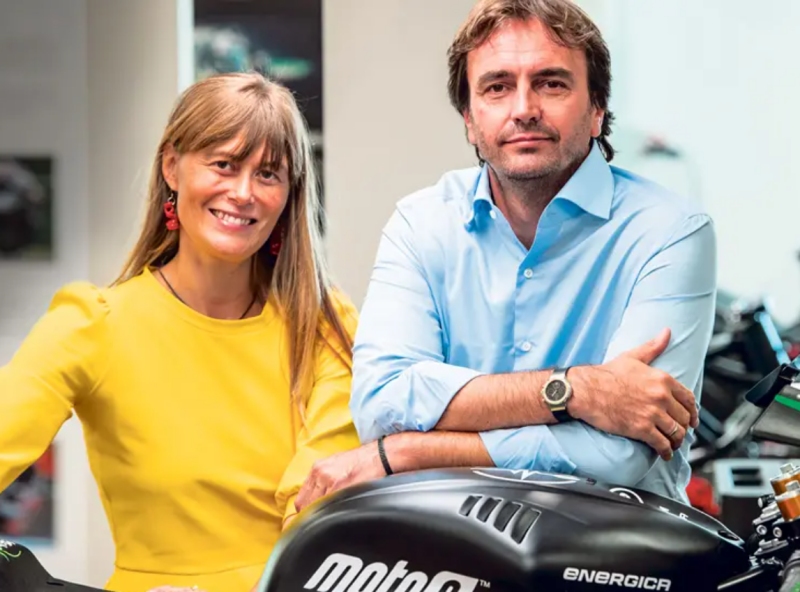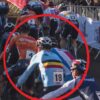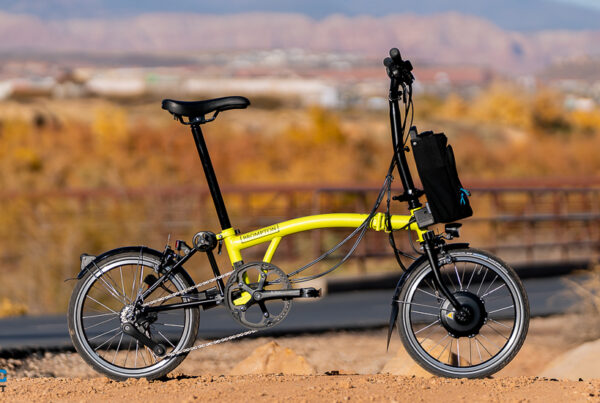Energica was formed in 2014 by Giampiero Testoni, head engineer for CRP Racing, which had won several European championships in the popular 250cc motorcycle class (they are also involved in F1 car racing parts design and production). He was approached in 2009 by the organizers of the TTXGP zero-carbon race (held on the Isle of Man), to encourage them to participate and design an electric race-bike. For the TTXGP electric race series to be successful, they needed several different credible competitors, and CRP was identified as a team that had the resources and a standing in the racing community that made them a good fit.
One year later in 2010, the “eCRP 1.4” bike won the European electric championship, so…I guess they figured out that whole “electric racing” thing…
Testoni’s team was able to build a running prototype of a production model for sale to the public, in time for the 2011 EICMA show in Milan. Based on the overwhelming interest shown, he forged ahead with plans for a series of production motorcycle models. They have their headquarters in Modena, right in the middle of the “motor valley”. This is also home to to Ferrari, Maserati, and Lamborghini…along with dozens of smaller custom design and manufacturing companies that serve the sports vehicle industry.
On the left is Livia Cevolini, a mechanical engineer and CEO of Energica. On the right is Giampiero Testoni, mechanical engineer, co-founder and Chief Technology Officer of Energica. And yes, they both ride…
__________________________________________________
Models
Their first production model was the 2013 EGO, and later the 2015 EVA Ribelle, and then in 2017 the EsseEsse9. In 2023, they will have a sport/touring model called the Experia…
In the 2019 model year, the entire drivetrain was upgraded using their experience from racing and the previous few years of production model data collection.
__________________________________________________
Battery
In 2019, Energica designed a larger 21.5 kWH battery pack, and also the rectangular case shown below.
The Energica family uses 81 Lithium cells in series (81S) which is a nominal 300V, and a full charge of 4.1V per cell is (x 81 =) 332V. When it gets down to 280V, the bike begins warning you to charge the battery…or plan on walking soon.
These are the design choices that interest me. The Ducati V21L (see our article by clicking here) uses roughly an average of 725V / 192S (806V when fully charged).
Zero Motorcycles has stayed with 102V / 28S system (115V when fully charged). To see our article on Zero, click here. The information I have indicates the lower cell-count of Zero batteries simplifies the Battery Management System / BMS to only 28 channels to monitor and balance. This was the easiest way to make the BMS reliable. Also, Zero was producing street and dirt motorcycles fairly early, and using 115V max meant they could include a simple and affordable slow-charger on every bike, since homes in the US have a standard voltage of 120V AC.
The higher voltages of the Energica and Ducati batteries (332V and 806V) were chosen to allow the fastest possible charging. Tesla cars and Zero motorcycles emphasize charging the vehicles’ battery overnight while you are sleeping, and when the US has excess electrical grid capacity that is typically unused.
Europe is way ahead of North America when it comes to the availability of public charging stations, and the European EV owner-profile is geared towards someone who takes a short drive, then tops-off the charge while eating lunch, or shopping.
Zero’s extended-range pack is rated for 220 miles under ideal conditions (click here) in city driving, and chat forums for the Energica models are posting ranges of roughly 120 miles in “real world” highway riding, in the “sport-bike” style (which is what they are designed for). The newest 2023 model from Energica is the “Experia”, which is outfitted as a highway touring bike. Although they optimistically rate the city range as 261 miles, the highway range (due to wind resistance at high speeds) is only rated at 130 miles. The Energica models are more powerful than the Zero’s, and that power makes them thirsty for battery watts.
Regardless of brand or model, this is one area where electric motorcycles are inverse to gasoline models. For a gasser, cruising along in top gear provides the best mileage, with city riding having a lower fuel efficiency. Electric motorcycles are a “one speed” with no transmission, a feat that is possible because of the exceptional torque. However, this means city driving will provide the best range, while highway driving is worse due to increased wind-resistance.
Electric vehicles can also use “regenerative braking” or regen. When slowing down, the motor can instantly switch to generating electricity to put some watts back into the battery, which helps range. Regen does not add as much range as most people might think, but even a few miles is better than nothing. The main benefit of regen seems to be that the brakes will often last as much as ten times longer, which can be a major benefit.
Energica has been using flat lithium pouch cells with the Nickel-Manganese-Cobalt / NMC chemistry. Everyone in the E-motorcycle and electric aircraft industries have stated that solid-state batteries will be a huge improvement, if…they ever start being produced. They work in the lab, but I haven’t found out what the holdup is for production.

In the picture above, you can see the radiator and oil/coolant pump that cools the controller base-plate first, and then it cools the hollow shaft of the rotor, and then it directly cools the stator of the motor (more on that farther below).
You can see that the monolithic block of the battery pack is hung from the top, which allows the weight of the pack to sit as low as possible. The battery case is also a stressed member of the frame, which allows the red frame shown to be lighter, and as a result it uses tube-walls as thin as 1.5mm. The trend in industry is to use large cast aluminum pieces to save on labor costs, but Energica is targeting customers that will pay a bit more for something with a little more of the vintage soul that they are used to.
This type of lattice frame is often called a trellis style, and it is labor intensive. The tubes are bent and cut by a computer-controlled machine, but the welding is still done by hand. Of course it is actually as strong as it appears to be, but due to how thin the walls of the tubing are, this steel frame is surprisingly light.

The original prototype for the case was 3D-printed by Windform, in order to verify all of the details that were designed in CAD. Then, large moulds were made for casting the aluminum alloy shells, with a CNC touching-up critical joints. This all happened very quickly because of CRP’s in-house expertise with modern methods due to their experience in supplying parts for F1 race-cars.
The central aluminum plate that separates the two halves is made from an aluminum alloy, and has air-channels to help cool the center of the pack. Energica is calling this part a “Septum”.
The 2014-2018 cells were provided by “Energy Innovation Group” / EIG from South Korea, and their MotoE racing pack used cells from Farasis-Energy. Farasis started in silicon valley (California), and has a production facility in Ganzhou China, near Hong Kong. They also plan to build a production facility in Germany. Energica has not stated where they are getting the cells for their current pack…

The round port shown with five sockets is the SAE J1772 smart-port using AC. The oval port with two large sockets is the CCS “fast charge” port that uses high-amp DC, which can “fill” the lower 80% of the battery in roughly 45 minutes. It costs less than $3 to add about 100 miles, and if you use the small on-board charger, it will take just under four hours to fill up a depleted battery.
________________________________________________
Motor
The 2019 motor is being called ECME for “Energica / Mavel Co-Engineering”. Mavel-Powertrain (click here) is a research, development and production company. They are based in Point-Saint-Martin, near the place where the French and Swiss borders connect to northern Italy. It is an oil-cooled radial-flux synchronous in-runner motor with interior permanent magnets / IPM.

2019 cooling system, pic courtesy of Ride Apart
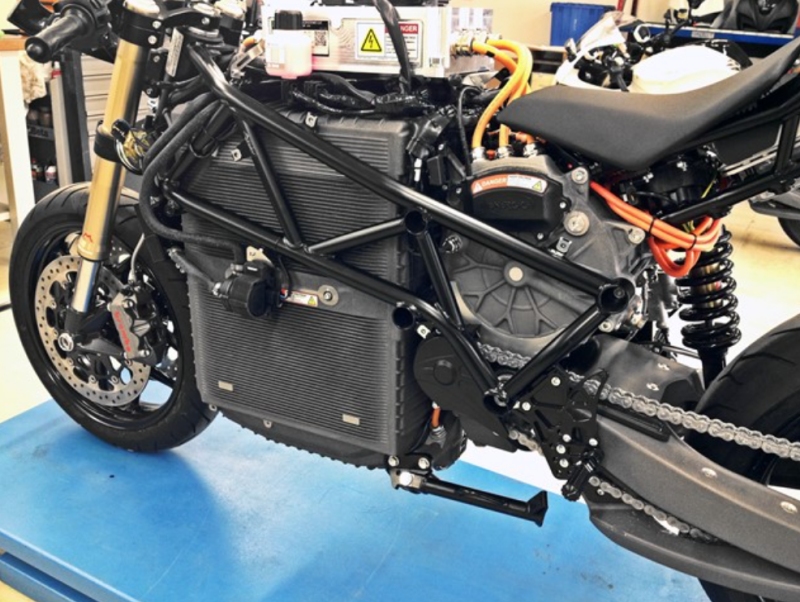
The 2019 Energica Ego
CEO Testoni stated “…The oil’s dielectric quality means there is no issue with short-circuiting when using oil for both lubrication and cooling…We cool the copper directly, not externally on the stator housing. We spray directly onto the windings, and we also have a hollow shaft in the rotor into which we pump oil directly. That cools the inside of the motor, and oil is also centrifugally spread throughout and across the outside of the rotor, for cooling and also to lubricate the motor-shaft bearings…”
The hollow shaft in particular was something custom that Energica asked for from their motor supplier, while Energica designed the housing and the oil pump. Also, the windings are impregnated with a thermal resin during the motor’s manufacture.
Lubrication of the reduction gears on the right side of the housing is achieved by encasing them with a separate oil sump.

In this pic of the right side of the motor, you can see the location of the three straight-cut gears that form the 2:1 reduction from the motor to the jackshaft. Energica considers the mechanical whine of this type of gear to be a benefit.
The front chain sprocket on the left side of the jackshaft has either 16 teeth, or an optional 15 teeth, and the rear has 44. The secondary reduction is 2.75:1. The transmission’s total reduction is just over 5:1. If the motor is spinning at 5000 rpm, the rear wheel will be turning at about 1000 rpm, and that gets you to an electronically-limited 125-mph (200 km/h). The torque and regen force of this drive system would have required a very wide belt, so Energica chose a chain for compact packaging.
The new ECME motor can make 126 kW (169 horsepower) at 8,500 rpm, and that’s a 25 horsepower gain over the previous motor. Max torque is now 159 pound-feet. The 2019 motor is lighter than the previous powerplant by 22 pounds.
__________________________________________________
EGO
Energica likes to call the EGO model “the Beast”. It has the most aggressive rider posture, along with many options for expensive carbon fiber panels to shave some ounces off of the stock weight. The carbon-fiber wheel rims are an eye-opening $3900 option. The EGO allows the rider to use the highest peak-amps that the drive-train is capable of when accelerating, compared to the other Energica models. Of course, the range will not be as good if you accelerate hard frequently.
The Corsa Clienti Kit is for track racing, and that is something that Energica has a great deal of experience with, since the EGO was the spec model for the 2019-2022 FIM MotoE race series.

Ribelle
The name means “Rebel” in Italian. It was formerly known as the EVA, and then the EVA Ribelle. The riding posture is slightly more upright than the EGO, but still somewhat aggressive. The modest seat only provides a limited area for a guest to accompany the rider, but…it is possible to bring a passenger. The EGO and Ribelle both have dual HID headlights.

EsseEsse9
The SS9 is the most “affordable” Energica, and it also has the most upright posture when riding. It only has a single headlight, among various other minor concessions to lower the price for enthusiasts. It has a larger seat for a passenger, compared to the Ribelle seat.
The EsseEsse9 is named after a popular Italian highway for weekend sport-bike riders. Its the “Via Emilia” (Highway SS9). It is 197 miles, and runs from Milan in Northern Italy (at the base of the Alpine mountain range), to San Marino on the Adriatic Sea (east coast of Italy).
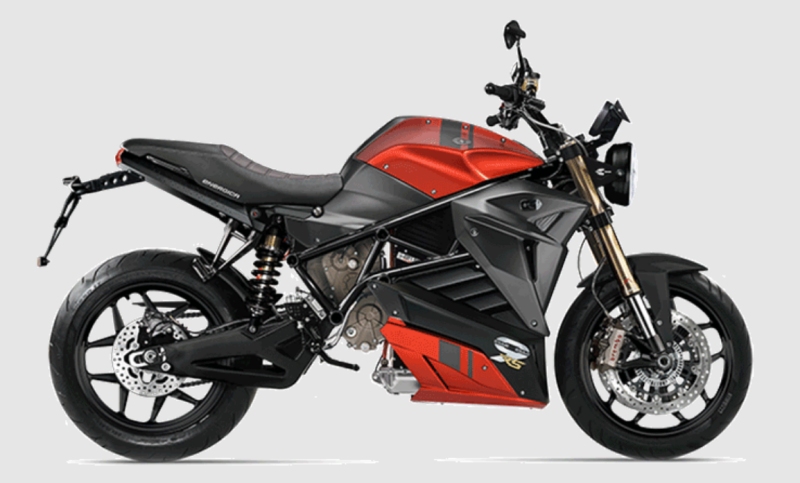
Experia
Customers have been asking for a sport/touring model with factory-added storage, and the Experia will be available in 2023.

There are a variety of performance options when ordering any model from Energica. There are also several color schemes for each. The four pictures above were chosen from the Energica website (click here) as being reasonably representative of each model. I haven’t listed prices, and they could range from $24,000 to well over $30,000 depending on options, and prices could also change from year to year, so check current listings at your closest Energica dealer.
I knew Energica existed several years ago, but it seemed at the time that they were only available in the European Union. As of October 2022, their website map suggests that they have 12 dealers in the USA right now, and I’m sure that there are more on the way. Because they are now readily available in the US, Jay Leno has recorded a test-ride segment on them, which is what prompted me to assemble the info here from several websites.
__________________________________________________
LINKS
The Energica page on Facebook can be found by clicking here.
The discussion group for Energica in ElectricMotorcycleForum can be found by clicking here.
The chat group for Energica from reddit can be found by clicking here.
Many thanks to the AEM Team for the excellent article found by clicking here.
Many thanks to Rory Jackson at E-Mobility Engineering for the best article on Energica tech, found by clicking here.
Many thanks to Jensen Beeler at Asphalt & Rubber for his great article and pics, found by clicking here.
__________________________________________________
Written by Ron/spinningmagnets, October 2022
Source link

